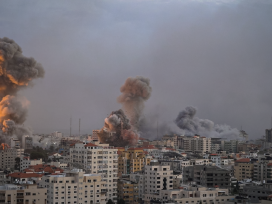Setting the stage for genocide
Israel has authorized a full military takeover of Gaza exactly twenty years after declaring it had ‘left’ the Strip. Disengagement failed because it was never designed to succeed – least of all on Palestinian terms.
Over the past few weeks, Israel marked twenty years since the “Gaza Disengagement”: the 2005 operation that uprooted 8,500 settlers and pulled out its troops. Presented as a way to ease Israel’s military burden and redraw its borders, the move bypassed the Palestinian Authority and left Israel in control of Gaza’s borders, airspace, and resources. Abroad, however, the withdrawal was seen as a bold step toward the two-state solution. As the EU’s foreign policy chief at the time, Javier Solana, put it, “The successful outcome of Disengagement will offer a momentous step for a peaceful future for Israelis and Palestinians, living side-by-side and enjoying security, economic prosperity and social well-being.” The EU, alongside its fellow members of the Quartet – the US, Russia, and the UN – placed disengagement at the centre of its roadmap diplomacy, effectively endorsing then-Prime Minister Ariel Sharon’s unilateralism as progress.

Gaza, February 2025. Author: Jaber Jehad Badwan / Source: Wikimedia Commons
Disengagement’s false promise
Two decades on, however, the promise celebrated abroad has soured at home. Israeli television marked the anniversary with dramas and documentaries that cast the evacuation as national trauma, inviting viewers to grieve with settler families and to see the October 7 attacks as its inevitable consequence. What such commemorations omitted, however, was the political logic of the time, which sought not resolution but deadlock: burying the two-state solution rather than advancing it.
Indeed, the move itself was strategic misdirection disguised as peacemaking. By tacking on the evacuation of four isolated outposts in the northern West Bank, Sharon could claim it was not “Gaza only”, even as he used the gesture as a shield against mounting diplomatic pressure. Shedding territory that had become a liability gave him the political space to tighten Israel’s grip on the West Bank. As his confidant Dov Weisglass admitted, the plan was meant to pour “formaldehyde” over the peace process – preserving a stalemate while bulldozers pushed new roads and housing deeper into the ridge-top towns.
Palestinians quickly understood what Israeli officials openly admitted: Gaza was being discarded as a token of flexibility even as settlement expansion in the West Bank accelerated. Israel still controlled Gaza’s skies, seas, and borders – and, with devastating effect, held a veto over every bag of cement required to rebuild homes, schools, and infrastructure after each wave of destruction.
The disillusionment with unilateral exit was not confined to Gaza. Israel’s retreat from southern Lebanon in 2000 had already shown how withdrawal without agreement risked drawing Israel back in with greater force. The fear seemed confirmed in 2006, when Hezbollah’s abduction of two soldiers triggered a war, thousands of rockets fell on Israel, the ground campaign faltered, and a state inquiry faulted the government for unclear objectives. The lesson many Israelis drew was blunt: further withdrawals, including from the West Bank, were off the table.
For Palestinians, the lesson was the opposite: militancy, not negotiation, could force change. Israel had withdrawn without consulting Mahmoud Abbas – or the Palestinian Authority – suggesting that diplomacy yielded nothing while Hamas’s rockets forced concessions. If settlers left only when violence made occupation untenable, militancy, not negotiation, appeared to be the lever of impact.
That belief helped Hamas win the January 2006 elections and seize control a year later. In response, Israel and Egypt imposed a blockade. Factories rusted, while Gaza’s university graduates found their degrees useless beyond the fence. For a generation raised without opportunity, ballots came to seem futile while tunnels and rockets delivered results. For hawks in Jerusalem, every rocket justified the siege; for militants in Gaza, every new restriction confirmed that only force registered.
The siege, however, was not Israel’s doing alone – or Israel and Egypt’s for that matter; instead, it soon hardened into an international policy. The United States and Europe cut direct aid to the Hamas-led Authority and confined their involvement to humanitarian relief. The EU’s civilian Border Assistance Mission at Rafah, launched in 2005, was suspended in 2007. What began as a regional standoff hardened into a policy of containment.
Even as Gaza was sealed off, the West Bank was being remade. The separation barrier crept far east of the 1949 Armistice Line (“Green Line”), enclosing settlement blocs. By 2020, the Trump administration’s “Peace to Prosperity” blueprint merely codified what expansion had already established on the ground.
The cycle of siege and war
The siege was punctuated by wars – in 2008-09, 2012, 2014, 2018, and 2022 – each framed as an “operation” meant to restore deterrence. Planners called it “mowing the grass,” treating militancy as a recurring task rather than the predictable result of statelessness. This rhythm hardened into doctrine. Each round left Gaza weaker but never quiet. By 2023, Hamas’s assault was less a rupture than a culmination.
On 7 October 2023, Hamas militants breached Gaza’s perimeter, attacked southern Israeli communities, killed roughly 1200 people, and took 250 hostages. Israel vowed to “destroy Hamas”. After almost two years of bombardment and incursions, Gaza lies in ruins: vast areas reduced to rubble, most of the population displaced, and Palestinian deaths surpassing 60000. Israel frames the campaign as existential self-defence; critics call it collective punishment, war crimes, and calculated starvation. An overwhelming majority of experts claims Israel’s actions in Gaza amount to genocide: a moral catastrophe that recalls atrocities Europe once pledged never to permit again. In bitter irony, Israel has now authorised a full military takeover of Gaza – framed as temporary – exactly twenty years after declaring it had “left” the Strip.
Disengagement failed because it was never designed to succeed – least of all on Palestinian terms. A genuine withdrawal would have transferred sovereignty together with responsibility. Instead, Israel retained levers of control while disclaiming duty for Gaza’s welfare. Unilateralism destroyed reciprocity, weakened moderates, and empowered extremists. Siege generated resistance, not submission – and security lacking legitimacy proved hollow. On 7 October, neither walls nor surveillance technology could erase proximity or quell resentment.
External actors helped entrench the deadlock. Washington and Brussels, once fluent in two-state diplomacy, reduced Gaza to a humanitarian crisis to be managed, not a political conflict to be resolved. Ceasefires displaced negotiations, and aid displaced political will. By accepting Israel’s self-justification, outsiders lulled themselves into believing the conflict could be quarantined.
The temptation to substitute recognition for responsibility has now returned in Europe’s new diplomatic choreography.
Recognition without de-occupation
As Gaza burns, Europe again reaches for policy gestures. France has said it will formally recognise Palestine at September’s UN General Assembly, joined by the UK, Australia, Malta, and Belgium. In parallel, France and Saudi Arabia co-chaired a UN high-level conference that produced the “New York Declaration”, a time-bound roadmap promising “tangible, time-limited, irreversible steps” toward two states. Yet for now, much of this momentum remains declarative.
The timing crystallises the tragedy. Exactly twenty years after Sharon’s “disengagement”, as Israeli operations continue in Gaza, European capitals prepare to recognise Palestinian statehood. Recognition, absent de-occupation, risks becoming mere ceremony in the shadow of devastation – the same logic that once traded withdrawal without sovereignty for the stability of a siege. The symmetry is unmistakable: where Israel once withdrew settlers while preserving control, Europe now offers recognition while acquiescing to control.
If recognition is to be more than theatre, it must come as recognition-plus: a binding UN Security Council resolution mandating time-bound settlement evacuation and land transfers; enforceable restrictions linked to settlement growth; transfer of borders, airspace and resources to Palestinian sovereignty; and robust support for Palestinian institutional renewal under a unified, legitimate leadership.
Disengagement was intended as respite; instead, it deepened despair. Two decades on, the warning is clear: a crisis merely managed will eventually manage us – and Europe, which once championed a two-state solution, cannot afford to stand aside. Recognition, on its own, will not arrest the drift. To matter, it must be anchored to concrete steps that deliver sovereignty and reciprocity rather than theatre. Otherwise, Europe will have rehearsed disengagement twice: first in Israel’s name, then in its own.
Published 17 September 2025
Original in English
First published by Green European Journal
Contributed by Green European Journal © Yonatan Touval / Green European Journal
PDF/PRINTNewsletter
Subscribe to know what’s worth thinking about.
Related Articles

Let our political imaginations soar
Blätter für deutsche und internationale Politik 10/2025
Gaza and the age of impunity; Islamism and leftwing anti-Zionism; dead-ends of Staatsräson; illiberal rap.

Moral truth
De Nederlandse Boekengids 8–9/2025
Thirty years on from the Srebrenica massacre, how The Netherlands has failed to acknowledge the ‘moral truth’ of the victims. Also: perspectives on the fascism debate; and why society needs a conversation about dying.





